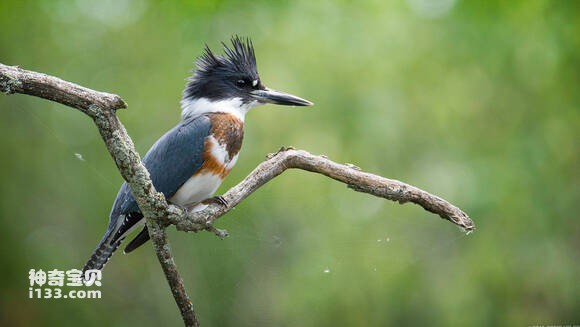Ceryle alcyon
IUCN
LCBasic Information
Scientific classification
- name:Ceryle alcyon
- Scientific Name:Ceryle alcyon,Belted Kingfisher
- Outline:Climbing birds
- Family:
Vital signs
- length:28-35cm
- Weight:140-170g
- lifetime:No textual research information is available
Feature
The forehead and top of the head are dark blue plumage, and the base and part of the tail are entirely white, more or less pale yellow or yellow
Distribution and Habitat
The white-bellied fish is found in North America (including the United States, Canada, Greenland, Bermuda, St. Pierre and Miquelon Islands, and the transition zone between North and Central America in Mexico), Central America (located between North and South America, Including Guatemala, Belize, Honduras, El Salvador, Nicaragua, Costa Rica, Panama, Bahamas, Cuba, Haiti, Jamaica, Dominica, Antigua and Barbuda, Saint Vincent and the Grenadines, Saint Lucia, Barbados, Grenada, Trinidad and Tobago, etc.), South America (including Colombia, Venezuela, Guyana, Suriname, Ecuador, Peru, Bolivia, Paraguay, Brazil, Chile, Argentina, Uruguay and the Malvinas Islands (also known as the Falkland Islands)
White-bellied fish dogs live in different types of water habitats. Lakes, mountain streams, coasts, mangroves, bays, swamps, rivers, reservoirs and calm seas.
Appearance
The dog is 28-35 cm long, has a wingspan of 48-58 cm, and weighs 140-170 g. The forehead and top of the head are dark blue feathers, and the eyes are white first. His cheeks are black. White collar, black circle around the neck sometimes intermittent. Playing back, tail, wings dark brown. The dorsal feathers have scaly markings. The bottom and subtail are entirely white, with a more or less pale yellow, pink or yellow tint. Some birds have fine black stripes on their chin, throat and chest.
The head has a grey crest and the head feathers spread over the neck. The throat and neck are white, with brown feathers mixed between the white belly and gray chest. The female has a red band superimposed between gray bands on the abdomen. The short legs, weight, and size of the head and neck are particularly out of proportion to the rest of the body.
The size is larger. Mouth long and flat side, peak ridge round; Nasal sulci was significant; The wingtip of the first primary feather is shorte
Details
Ceryle alcyon, Belted Kingfisher, no subspecies.

White-bellies emit clear chirps to warn when threatening intruders or partners. Very territorial, most of the homeland defense measures are through voice commands or shouts of deterrence. The sound is similar to the tapping of vibrating machinery. A short shriek threat occurs between two partners. The method of finding prey is similar to other kingfishers. This migration, despite their ability to tolerate the harsh low temperatures of the North American climate. The main diet consists of fish, mostly trout, dusky fish and Atlantic salmon, which usually consume small fish. When fish are scarce they also eat mollusks, crustaceans, aquatic insects (dragonflies), amphibians, reptiles, other species of baby birds, small mammals and berries.

During spawning, white-bellied dogs actively defend their territory. Male birds, in particular, will react immediately if they spot someone plotting to deviate, raising their feathers to warn of aggression. In this species, the male will provide song and food to the female. When the mating relationship is established, the male and female will work together along the bank to dig a nest 80 centimeters long in the loose sand or clay layer. Nests are usually built near fishing areas. The female usually lays six to eight eggs at a time and hatches for 22 to 24 days. Both parents take turns incubating the eggs. Young birds typically leave the nest on 28 days, but remain with their parents for three weeks.

Listed in the International Union for Conservation of Nature Red List of Threatened Species (IUCN) for 2016 ver 3.1 - Not Threatened (LC).

Protect wild animals and eliminate wild meat.
Maintaining ecological balance is everyone's responsibility!








